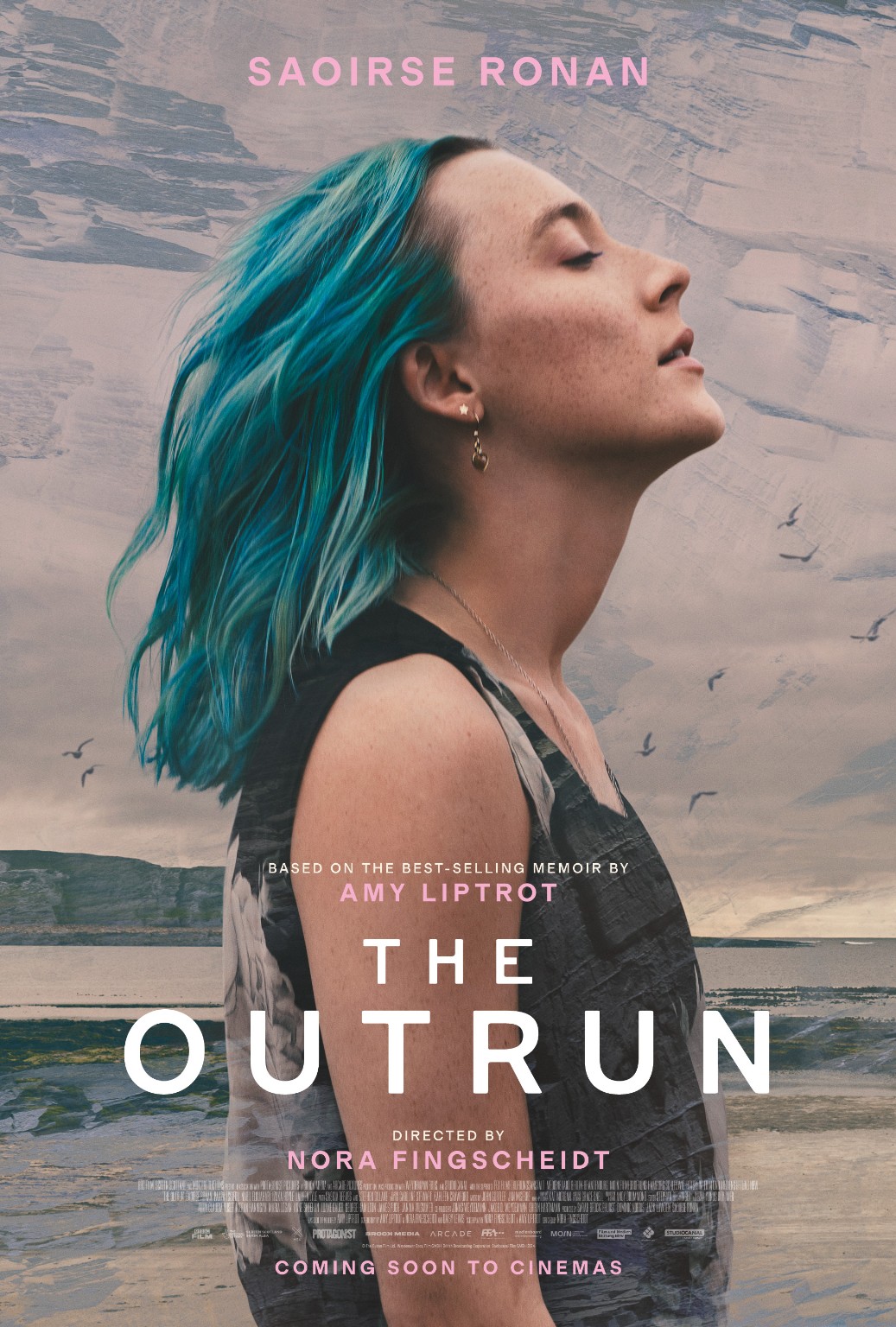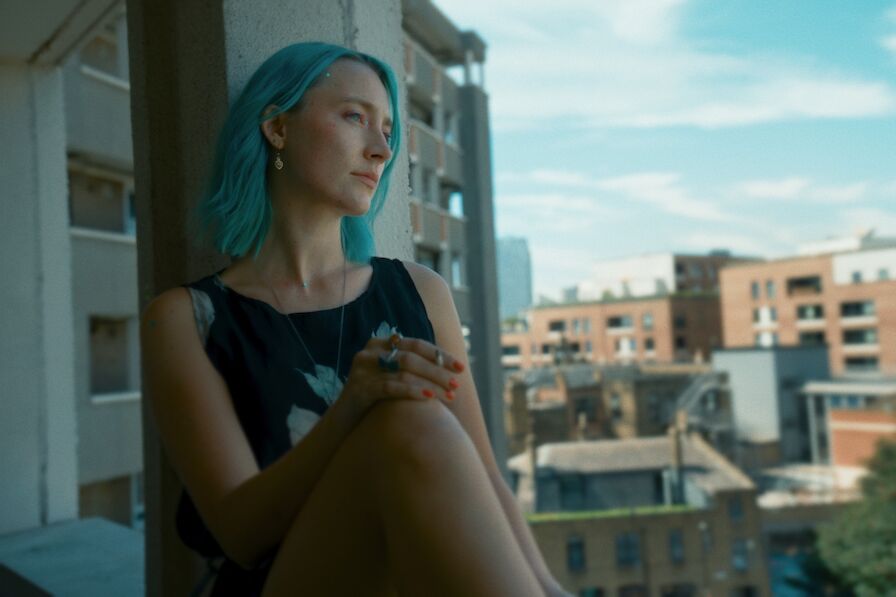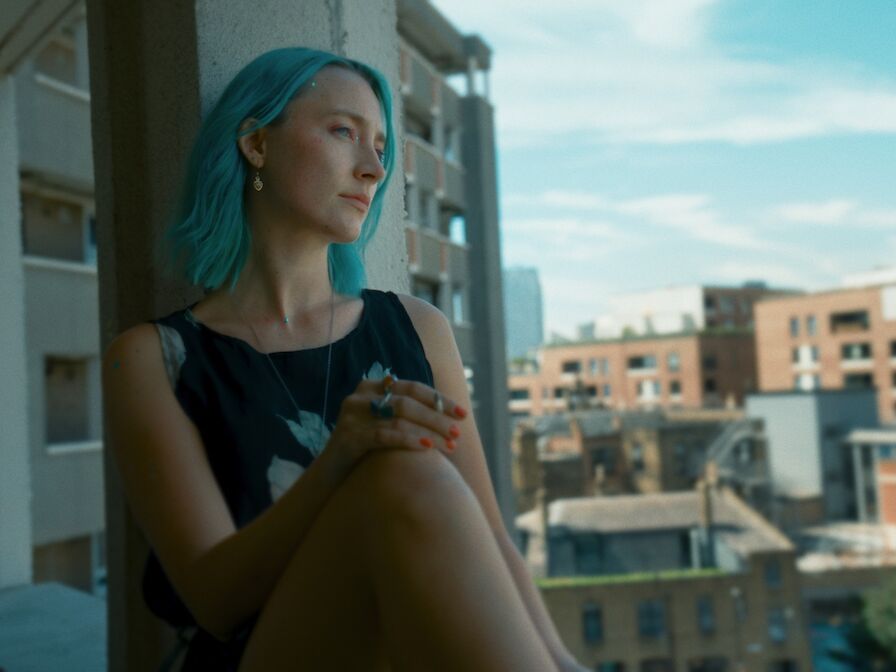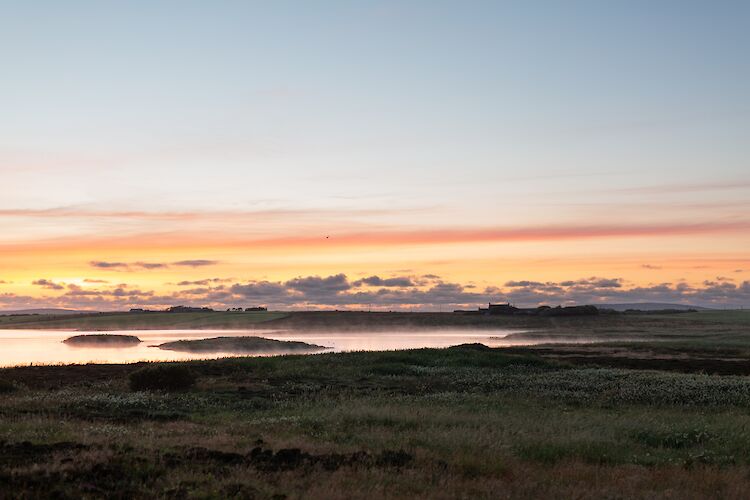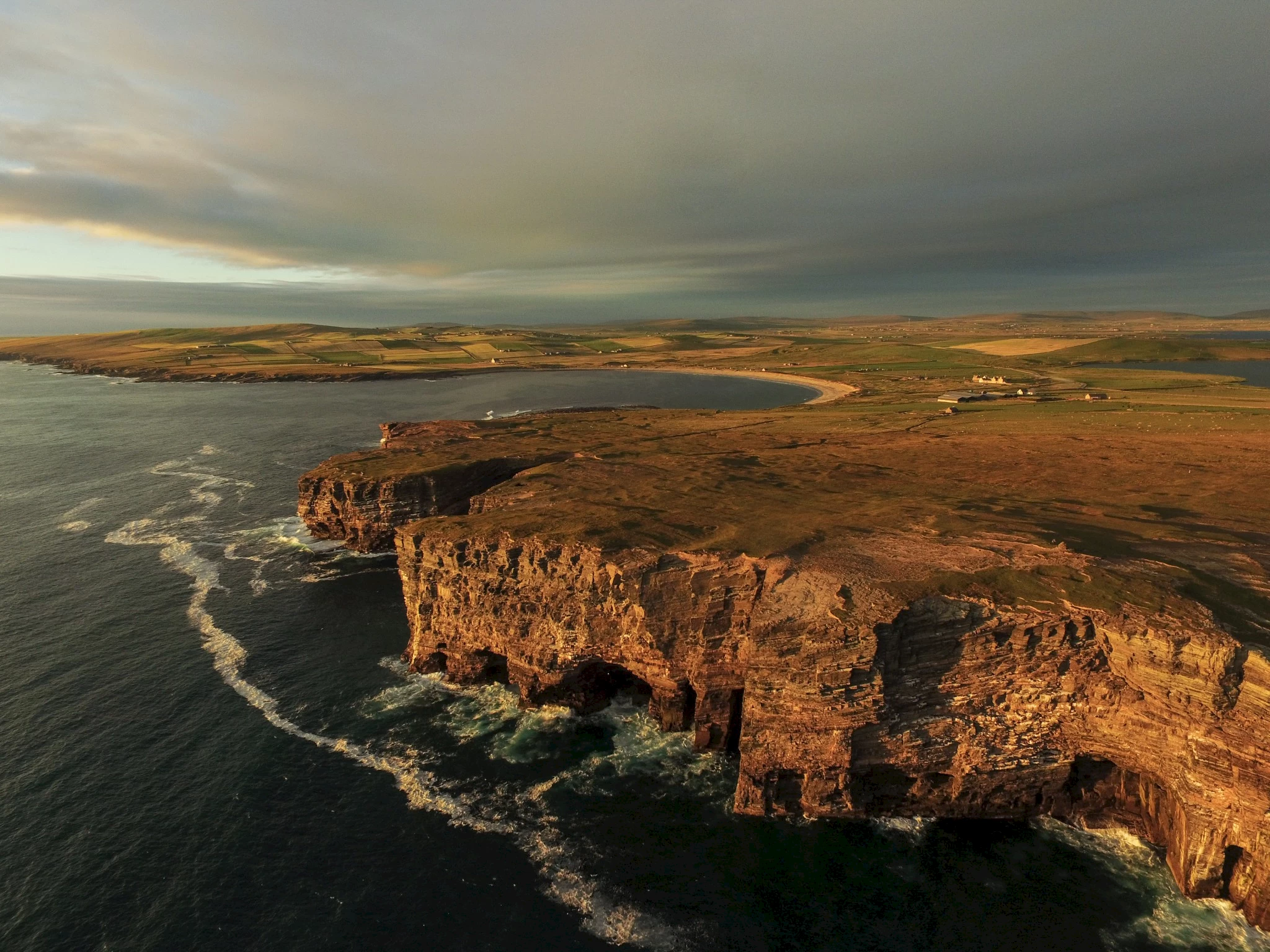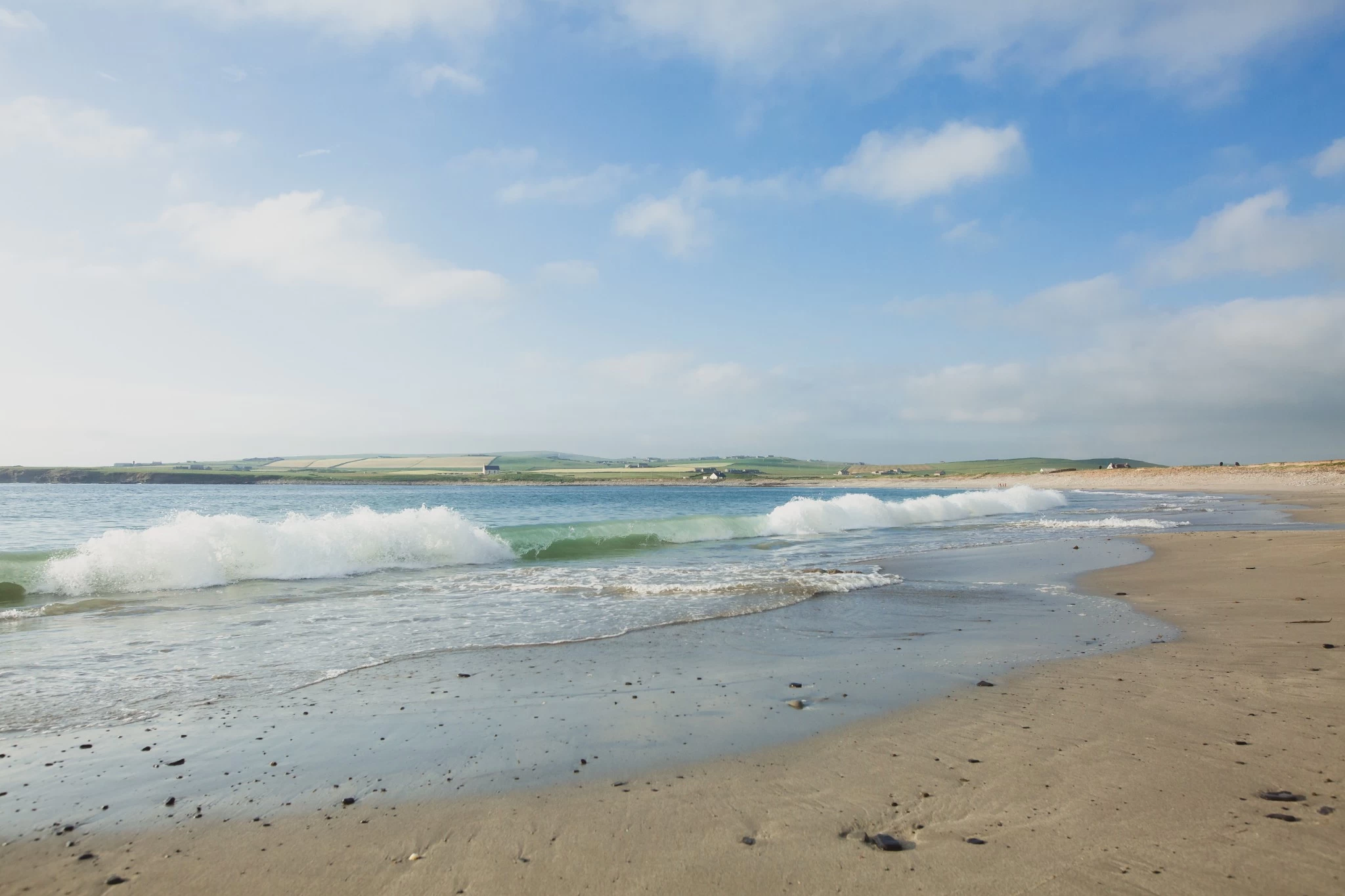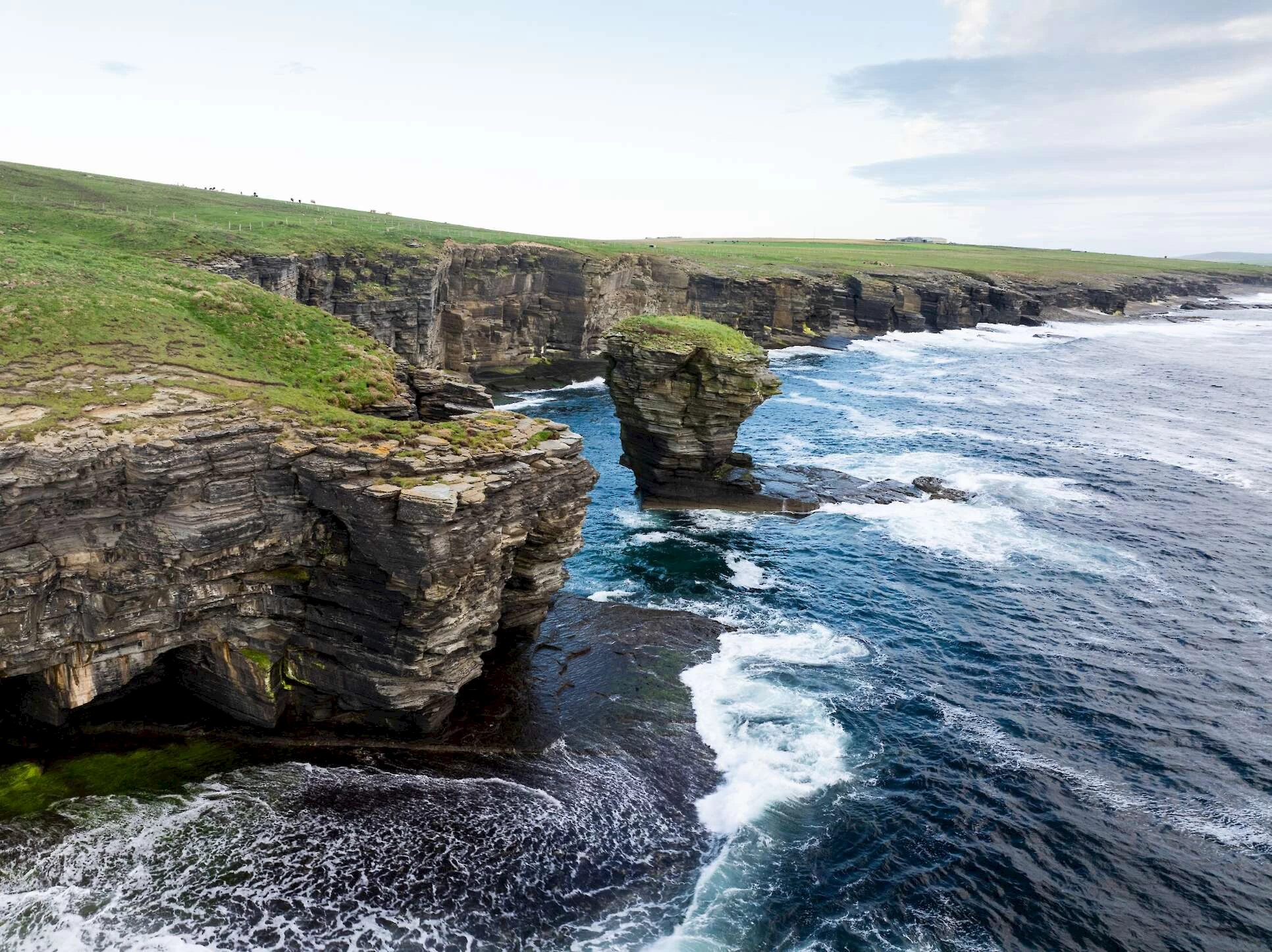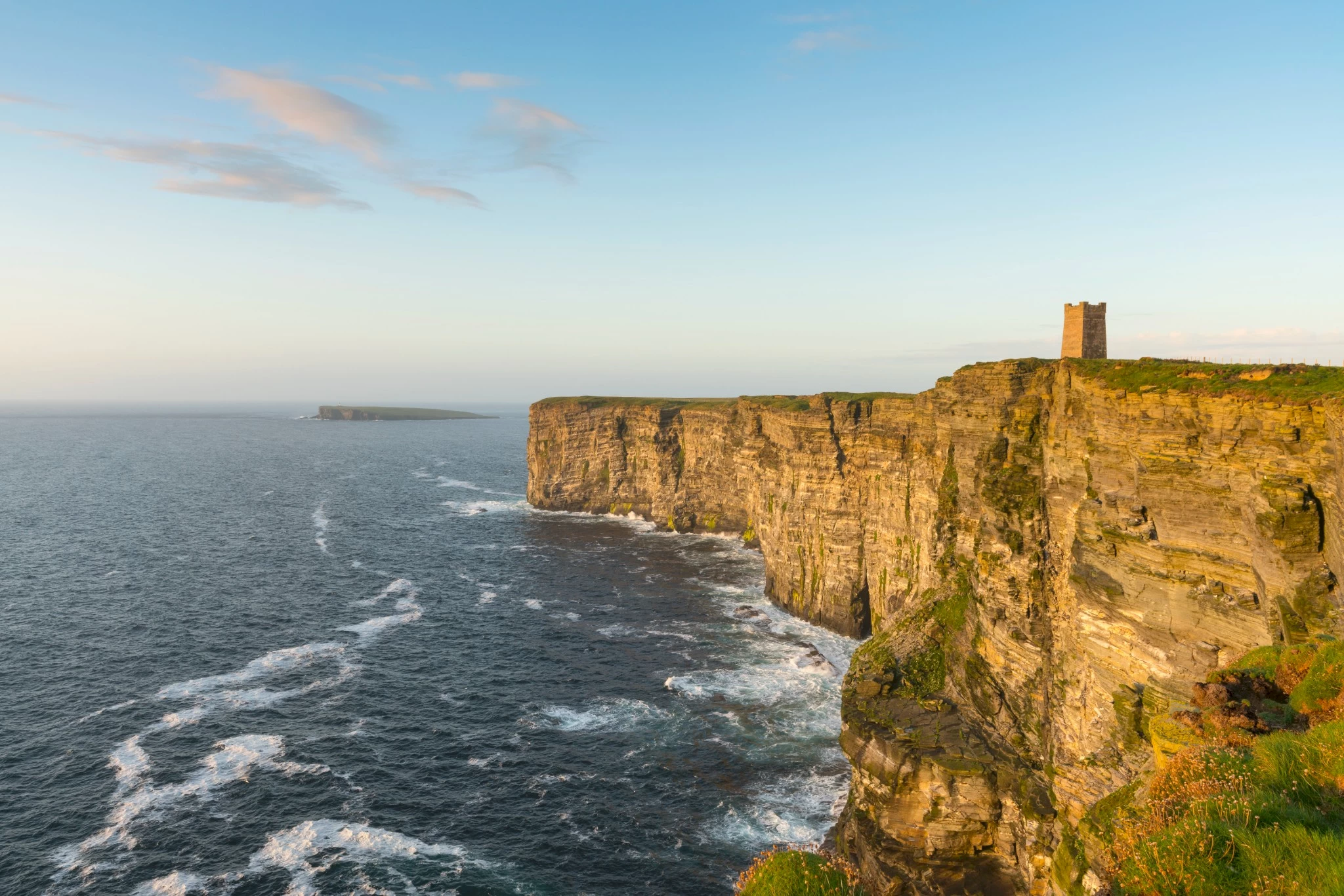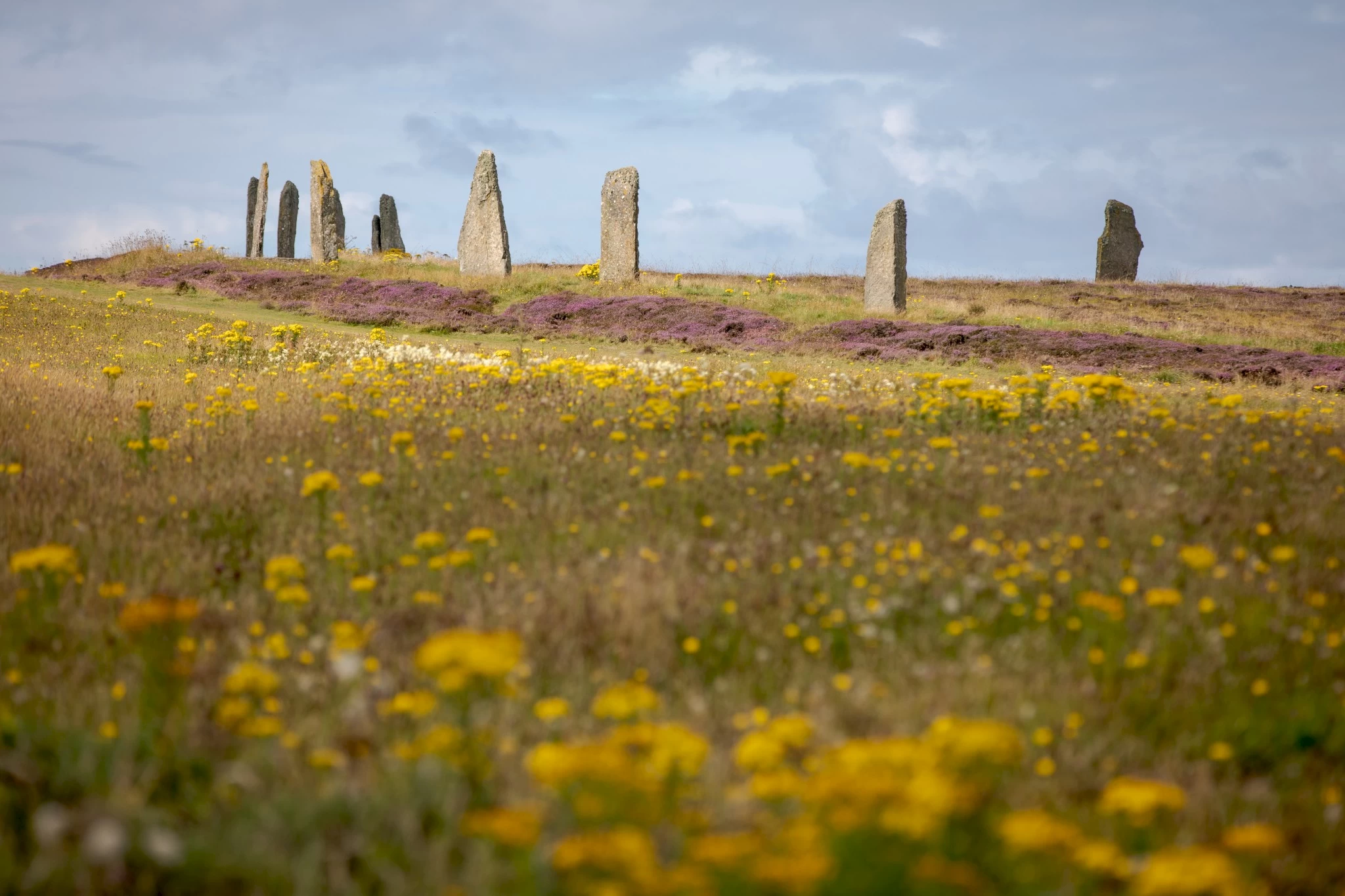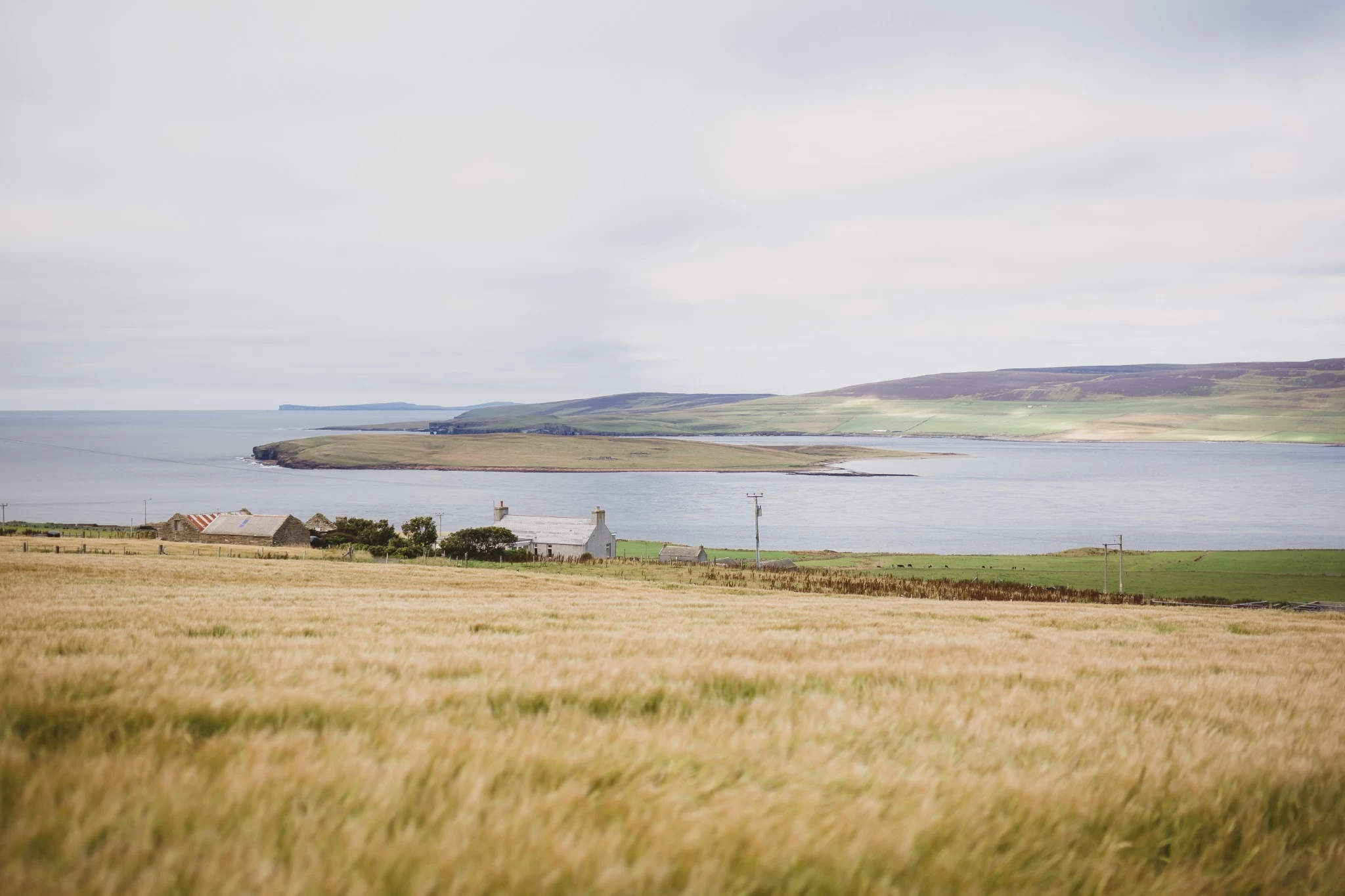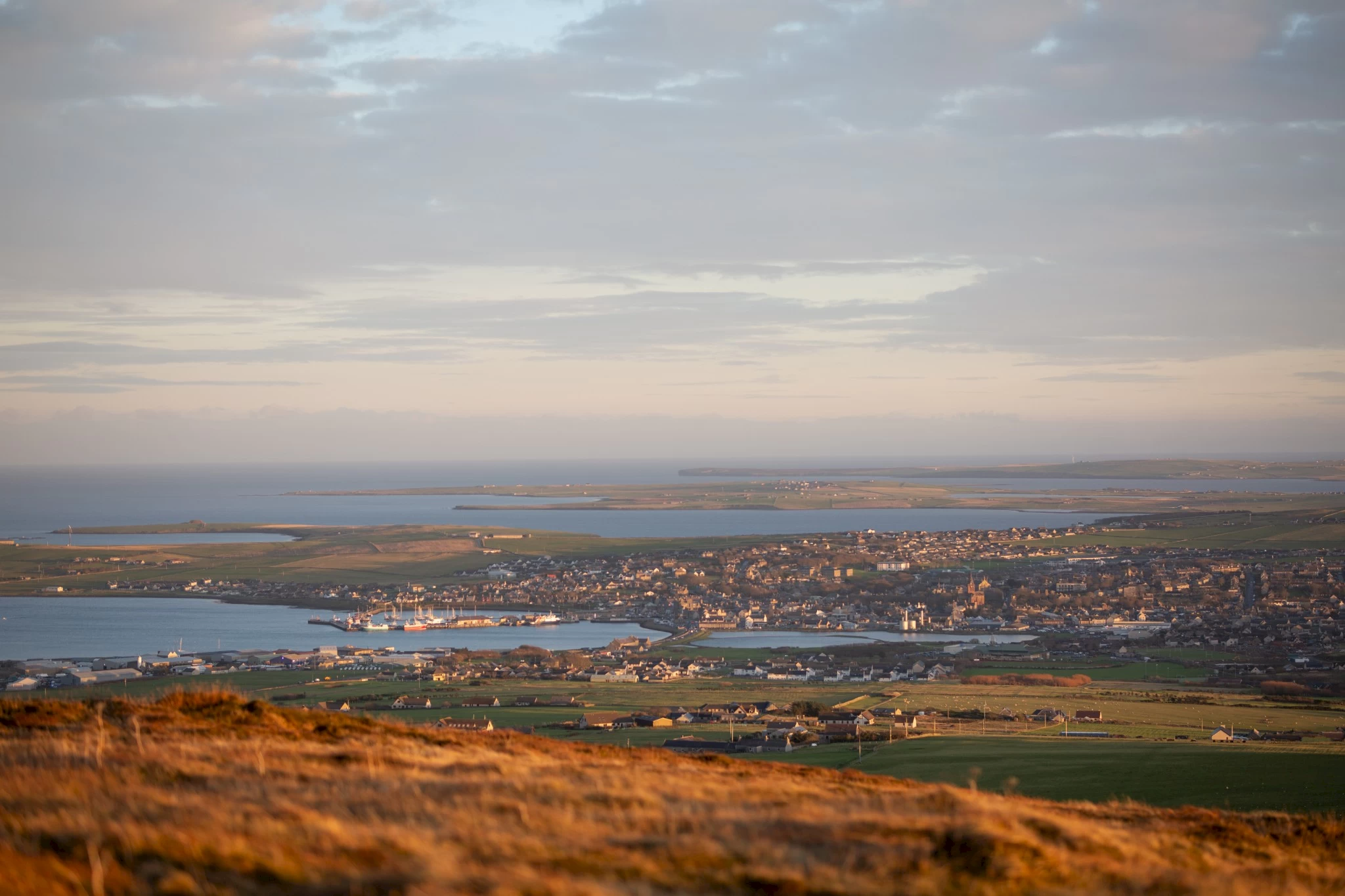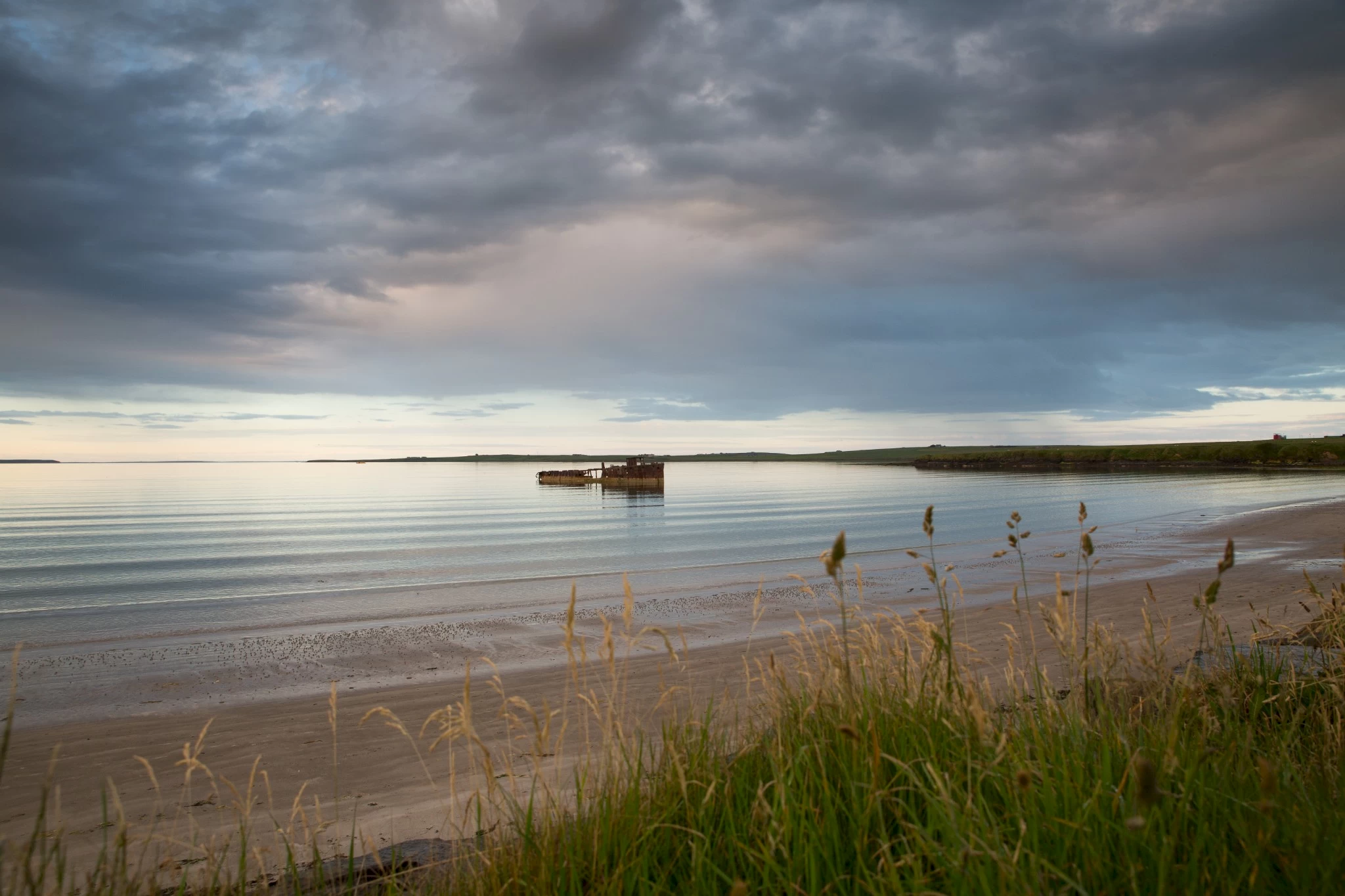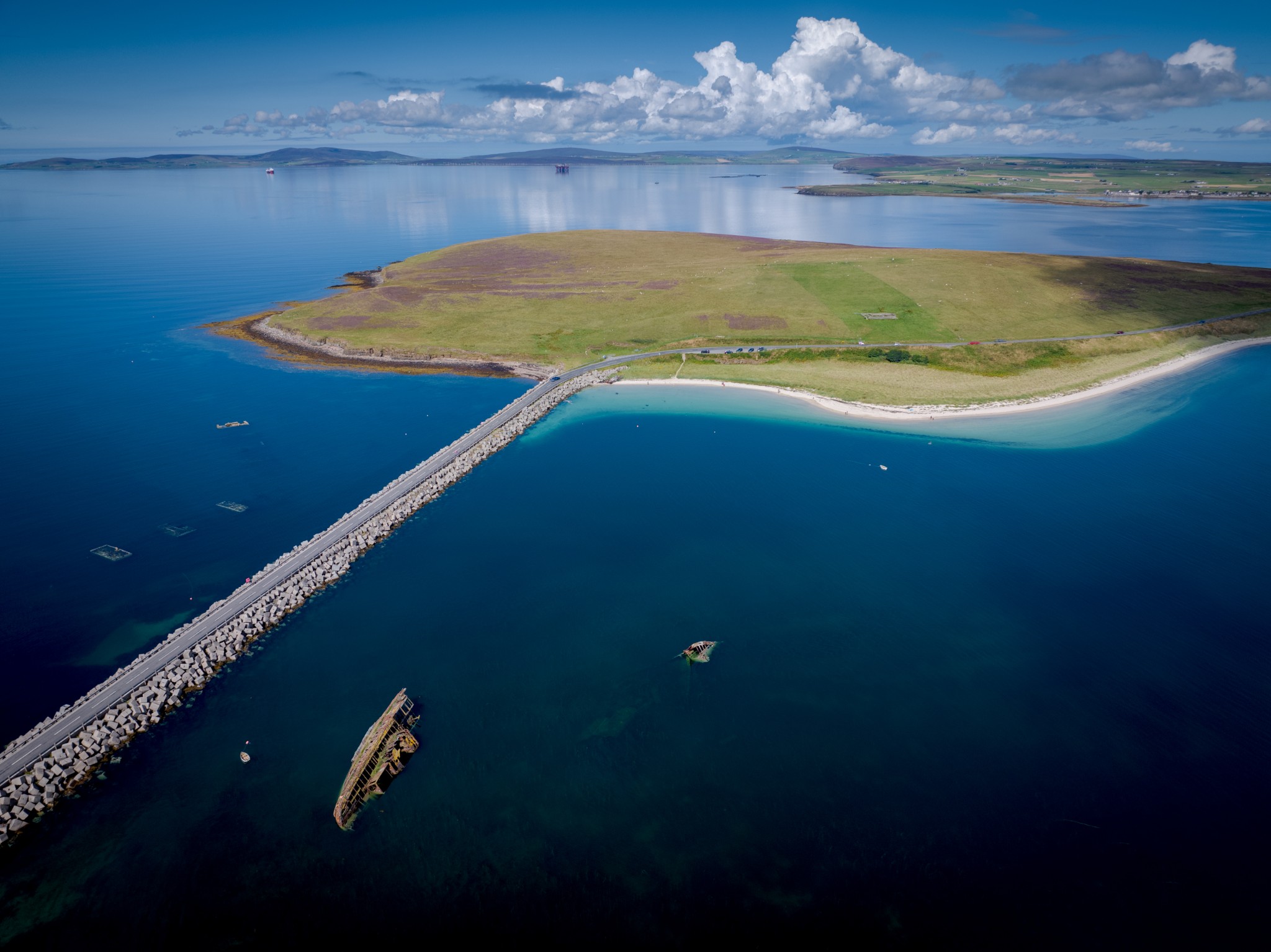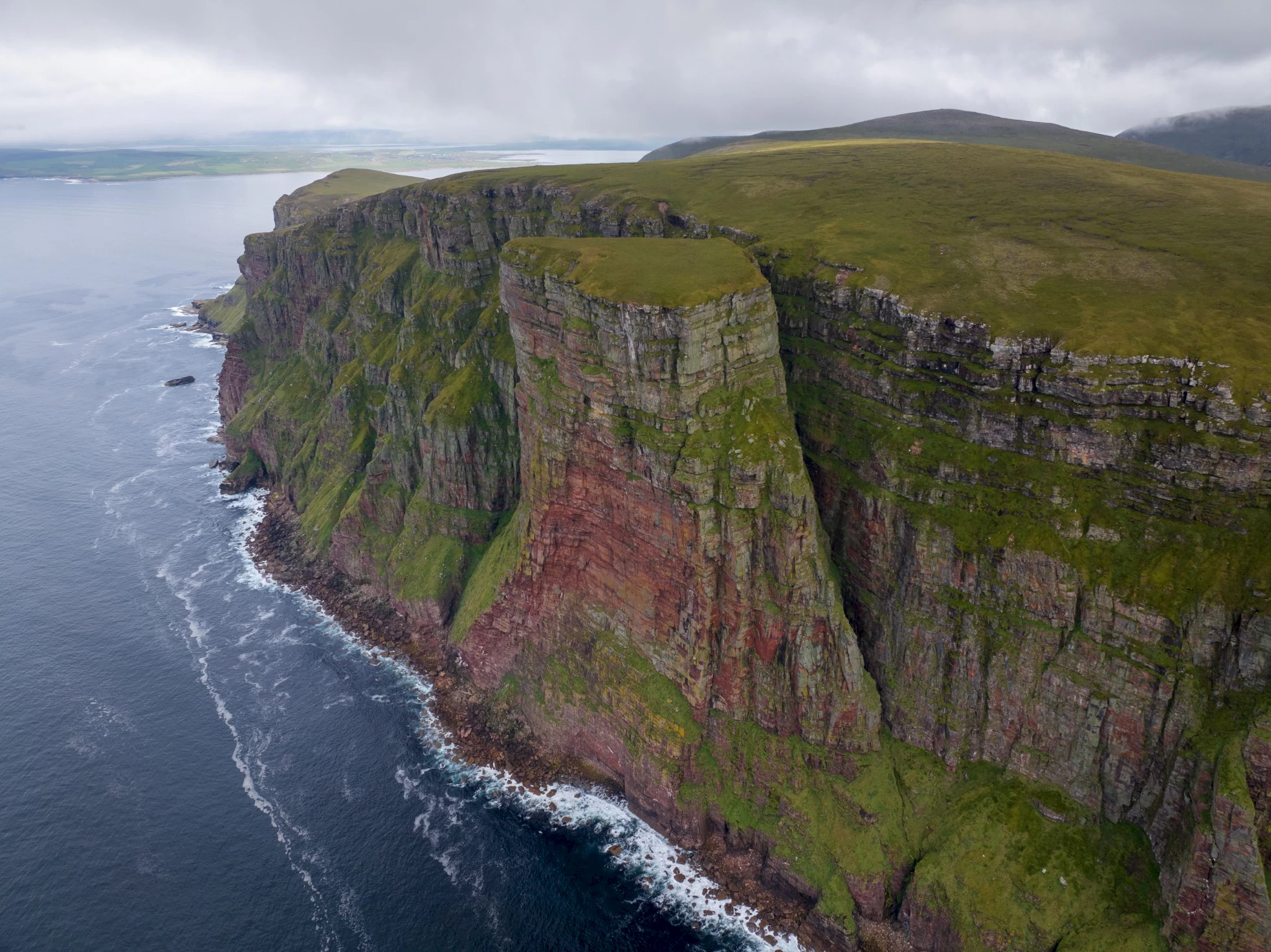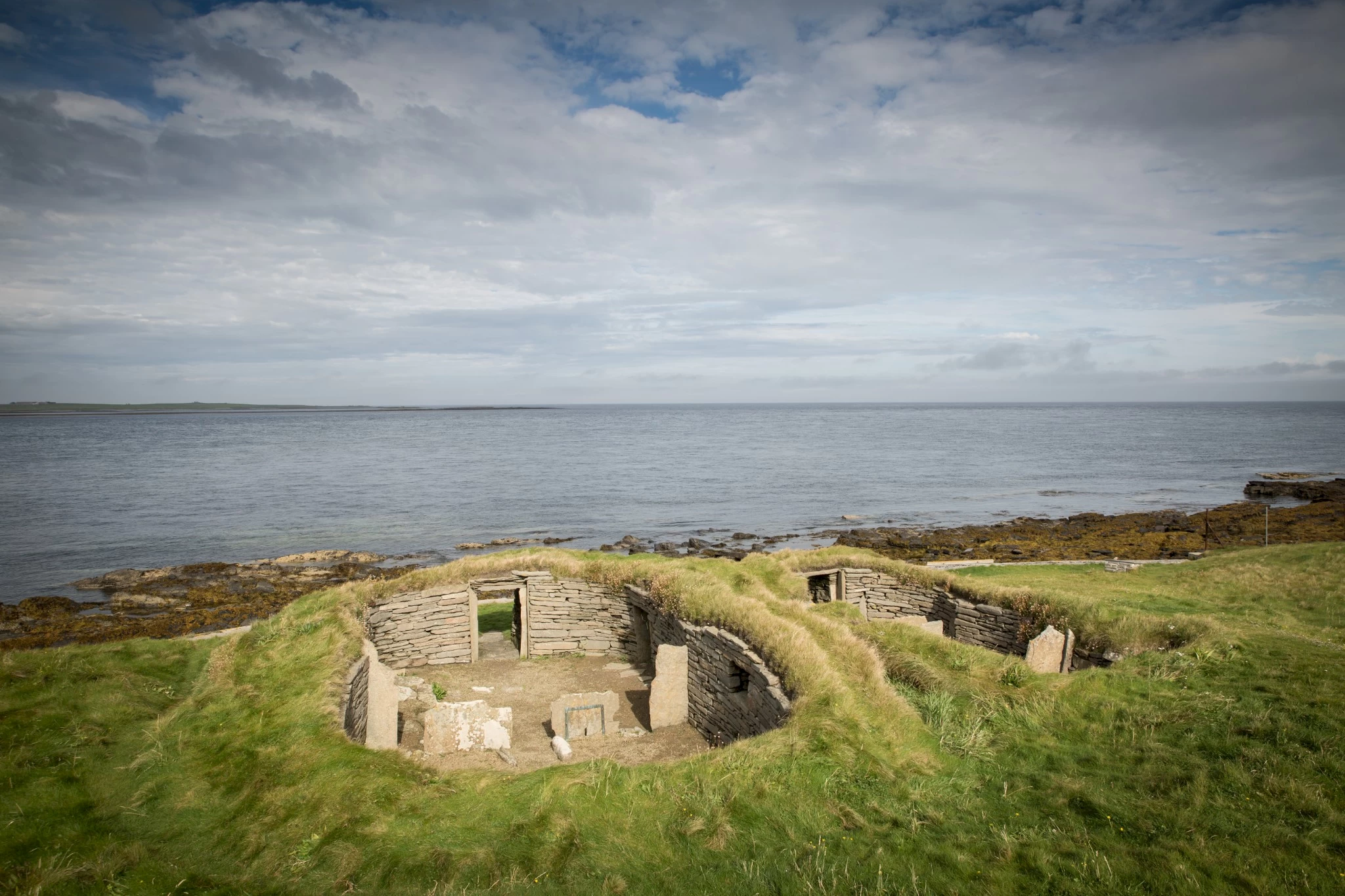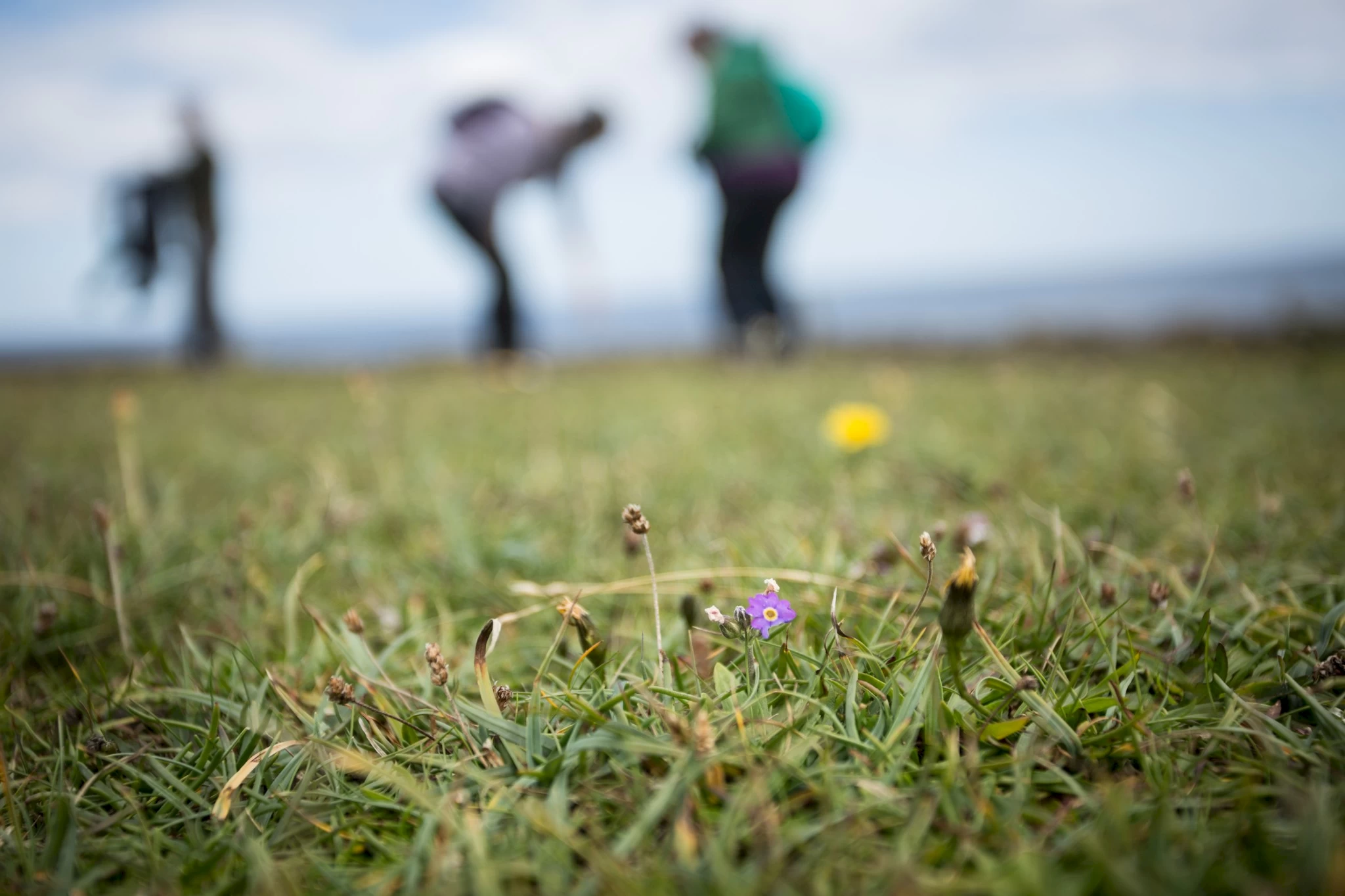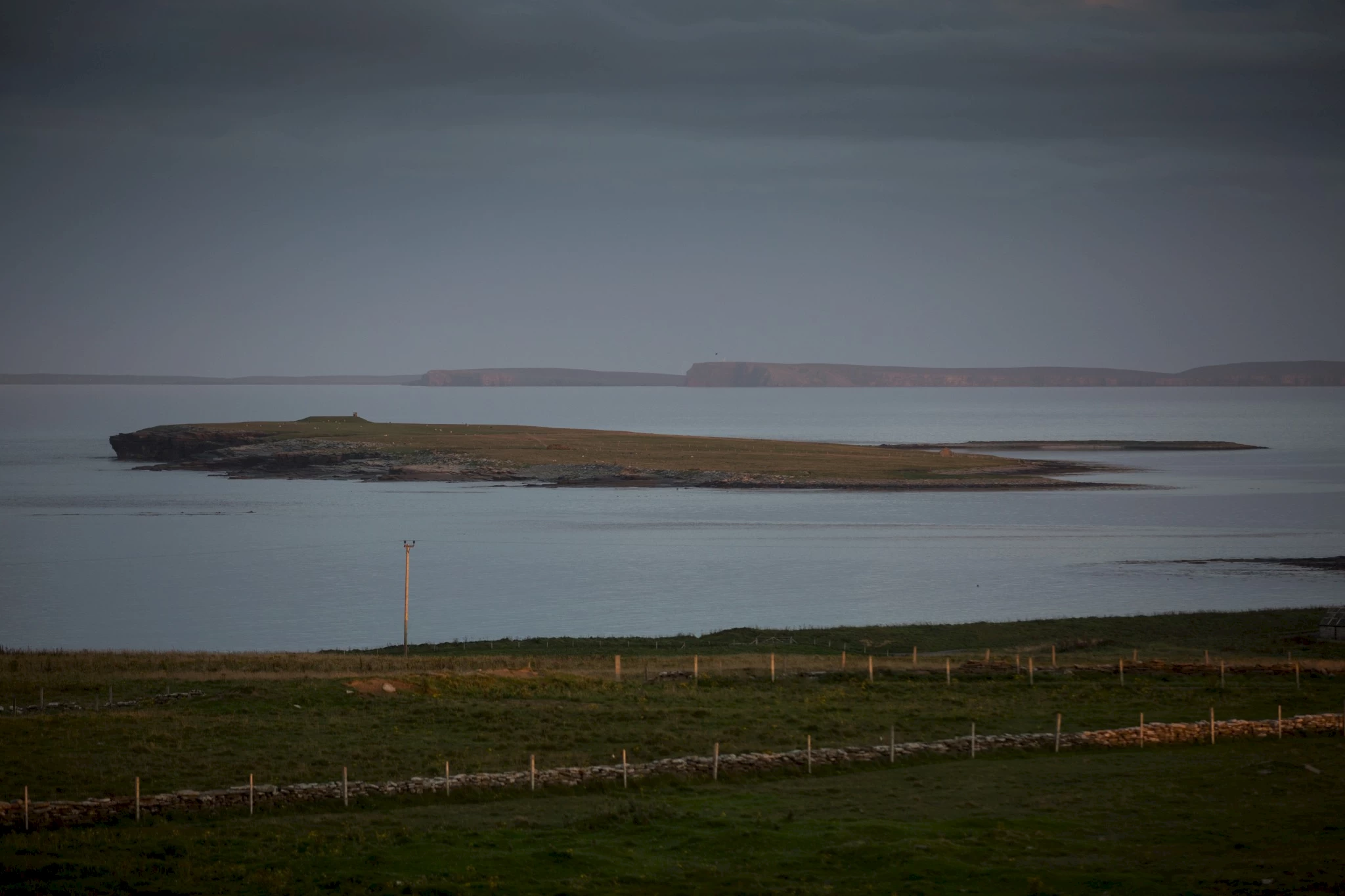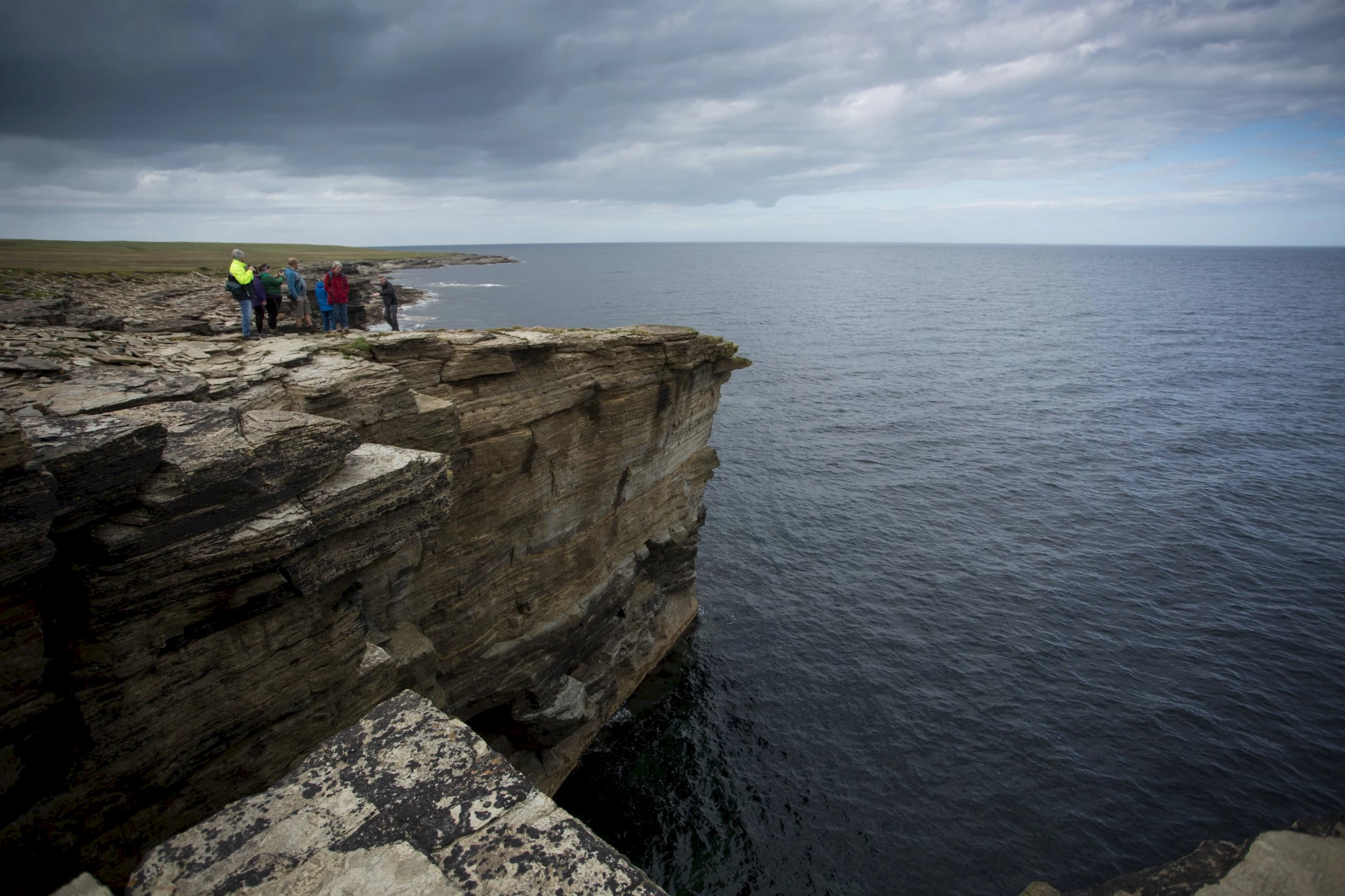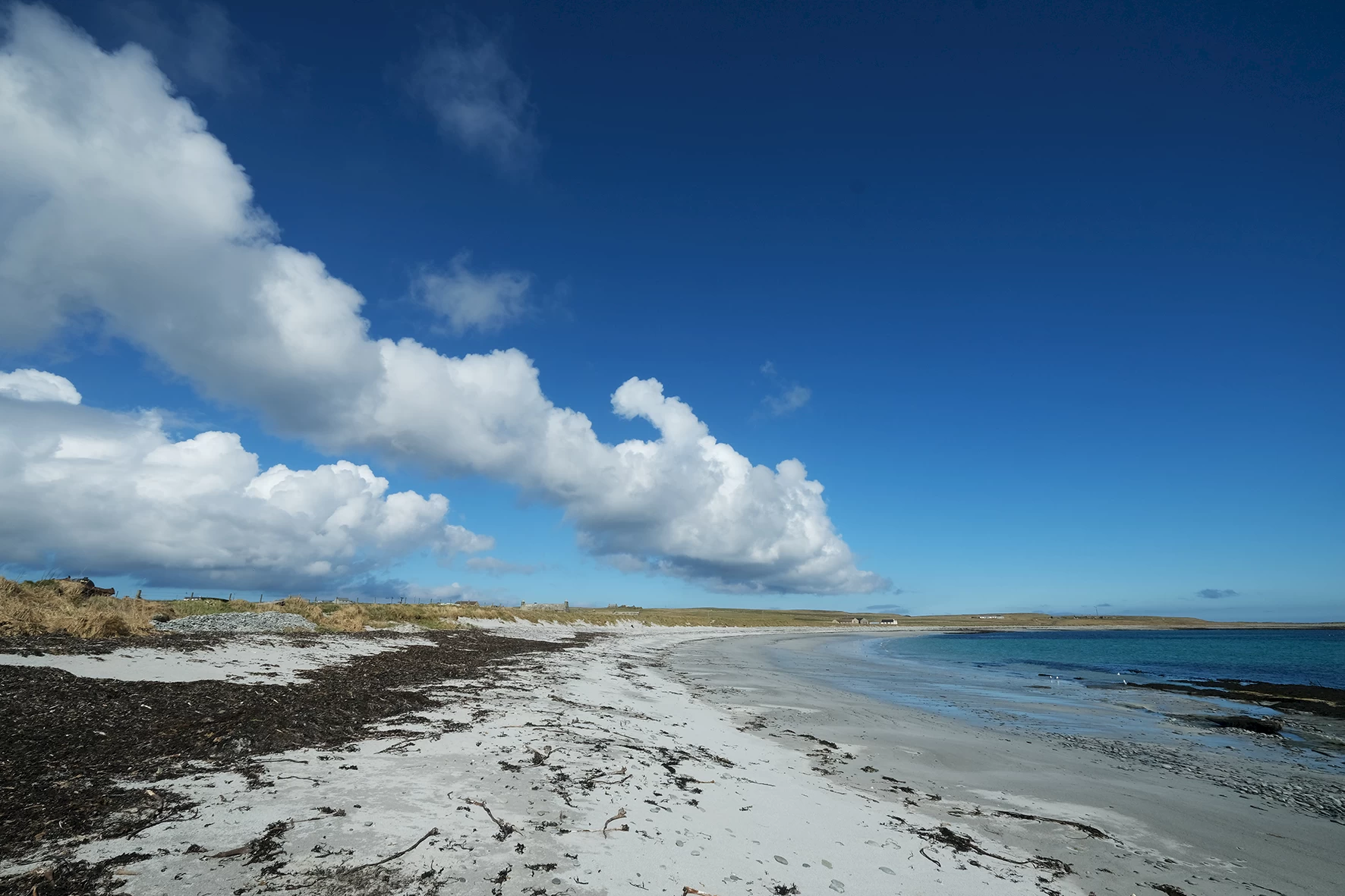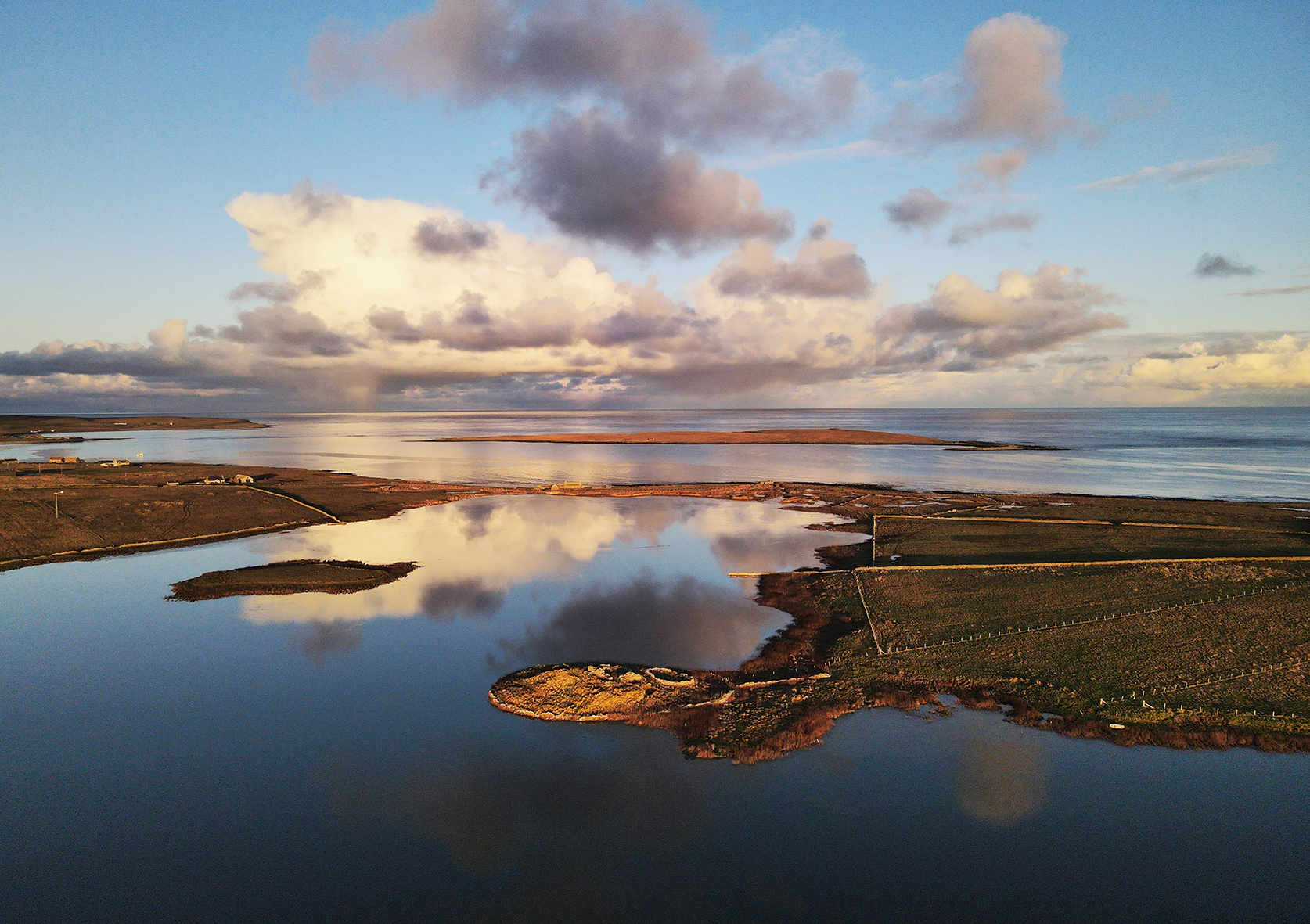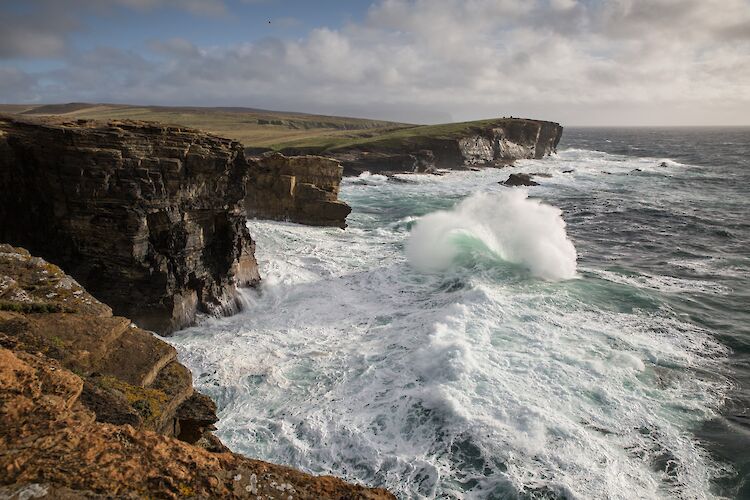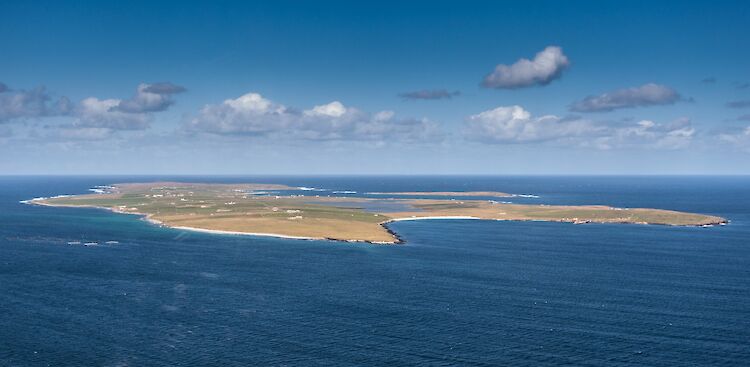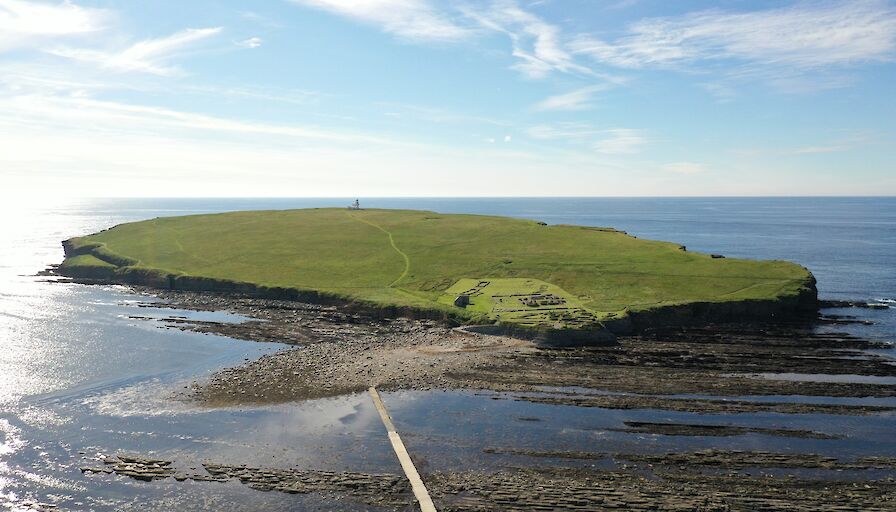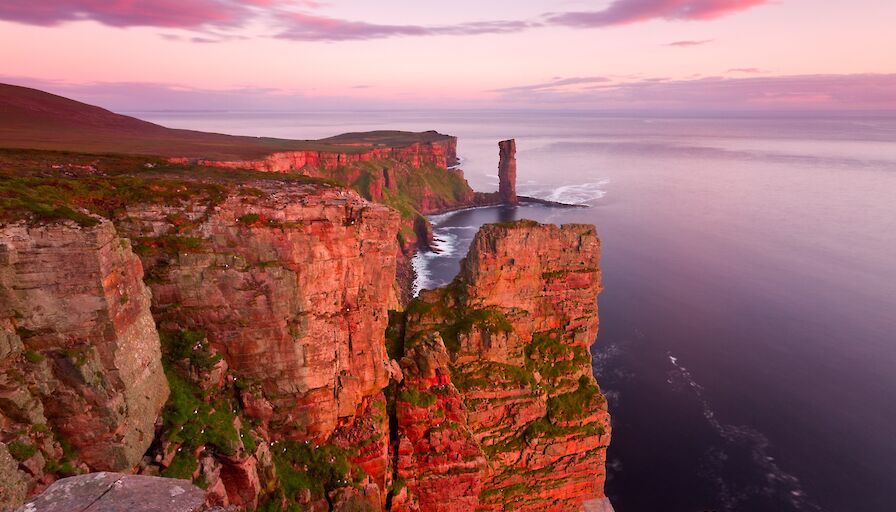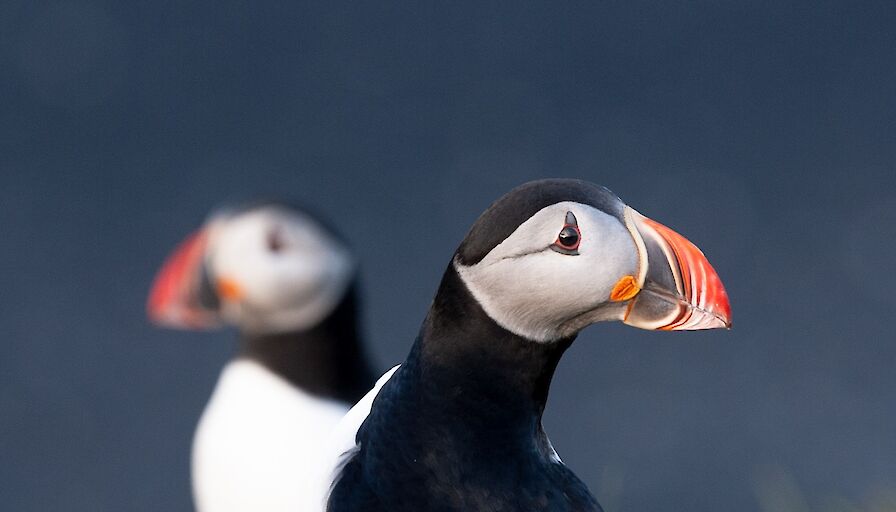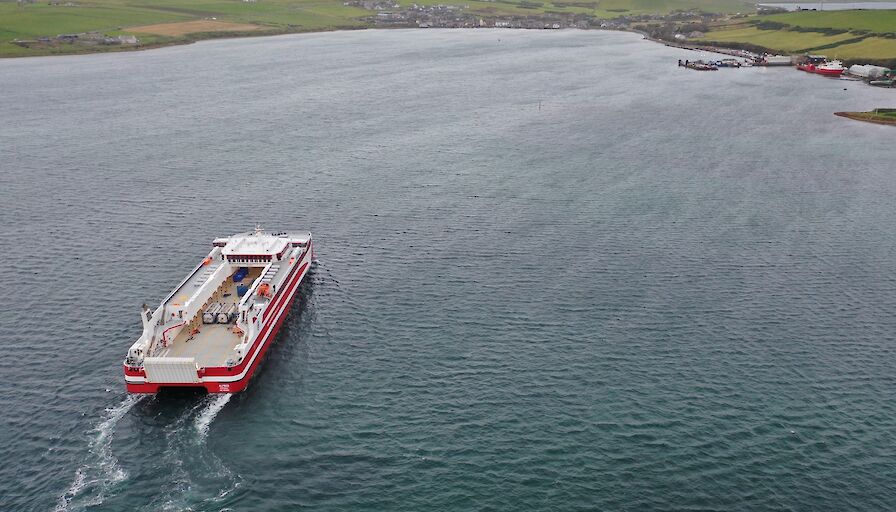Orkney arrived on the silver screen in 2024 thanks to 'The Outrun', the film based on the best-selling memoir by local author, Amy Liptrot.
Partly shot in the islands during 2022, 'The Outrun' is a brutally honest drama about addiction and recovery, strength and survival, mental health and the ability of the sea, the land and of people to restore life and renew hope.
After a decade away in London, 29-year-old Rona returns home to Orkney. Sober but lonely, she tries to suppress her memory of the events which set her on this journey of recovery. Slowly the mystical land enters her inner world and - one day at a time - Rona finds hope and strength in herself among the heavy gales and the bracingly cold sea.
The film stars four-time Oscar-nominee, Saoirse Ronan, alongside Paapa Essiedu, Saskia Reeves, and Stephen Dillane. It's directed by Nora Fingscheidt from a screenplay by Amy Liptrot and Nora Fingscheidt.
Amy's raw and honest book describes how Orkney's wild landscape and natural world helped her during her recovery, from sea swimming in our cool, clear waters, to searching for the elusive corncrake during midsummer nights.
We've brought together all the information and inspiration you need if you want to experience the Orkney described so vividly in both the film and book versions of 'The Outrun' and explore some of the locations Amy - and Rona - visited.
Would you like to visit some of the locations featured in the book and movie versions of 'The Outrun'?
We've picked out a selection of places where you can connect with Amy's own experiences, and some of the nature, wildlife and history depicted so beautifully in print and film. Use our map below to build your own 'The Outrun' itinerary.
Each pin on the map corresponds with the relevant entry below - click on each block to find out more.
- 1 - The Outrun
The Outrun is a stretch of coastland at the top of the farm where the grass is always short, pummelled by the wind and sea spray year-round.
The actual Outrun that Amy describes so vividly in her book is part of a private farm so we can't reveal the exact location, but there are many places on the west coast of the Orkney mainland that are incredibly similar, with the sea spray, the breeze, the sunsets and seabirds that Amy experienced growing up in Orkney and during her time back in the islands. The coast at Rowe Head, just south of the Bay of Skaill, is seldom visited and offers beautiful coastal views and plenty of nooks and crannies to explore.
- 2 - Bay of Skaill
The Bay of Skaill, a mile-long beach where the Stone Age village, Skara Brae, sits.
This huge sweep of sand faces the Atlantic Ocean and is one of the most dramatic places in Orkney when wild weather hits. In calmer conditions it offers a beautiful beach walk, and you'll often share the shore with locals, their dogs, and visitors from all over the world, thanks to the close proximity of Orkney's Neolithic village, Skara Brae.
- 3 - Stack o'Roo
There is a sea stack known as ‘the Stack o’Roo’, a tower-block-sized rock that was once part of the cliff but now stands alone. In the summer, puffins rest on the stack, along with fulmars, shags, black-backed gulls and ravens.
The Stack o'Roo is one of many sea stacks to be found around Orkney's coastline. These stacks tend to be havens for birdlife and offer spectacular views. Other similar locations include the Old Man of Hoy, Yesnaby Castle, the Standard, and North Gaulton Castle. The best way to reach the Stack o'Roo is to park up at Marwick Bay and follow the coastal trail south, past the Fishermen's Huts.
- 4 - Marwick Head
From my seat on the slab, I look north to the headland at Marwick, with the stone tower built in memorial to Lord Kitchener.
One of the most dramatic locations in Orkney, Marwick Head is a seabird city during the summer months, with the huge cliffs full of breeding birds. It's the perfect spot to watch the sun set over the Atlantic Ocean, and you can also visit the memorials to Lord Kitchener and the crew of HMS Hampshire, lost at sea just off the headland during the First World War.
Image courtesy VisitScotland/Kenny Lam
- 5 - The Ring of Brodgar
I sheltered behind one of the standing stones at Brodgar, and the night sky formed a glittering canopy over the low hills and dark lochs that circled me.
The Ring of Brodgar is an ancient stone circle that forms part of Orkney's UNESCO World Heritage Site. Amy recalls visiting Brodgar 'one still-pink dawn, just before midsummer' during her work with the RSPB as Corncrake Officer.
- 6 - Eynhallow
Eynhallow – associated with the stories of vanishing islands Hether Blether and Hildaland – is a ‘holy island’, with an important part in the history of Orkney and the Norse Orkneyinga Saga.
Although you can't visit this uninhabited island, it is a place you can take in from afar, or via the ferry between the Orkney mainland and Rousay. Eynhallow is at the centre of many Orcadian traditions and folklore, and also houses the ruins of a chapel which may have been an early Christian monastery. The island was abandoned in 1851. The Orkney Heritage Society does arrange an annual expedition here – the only opportunity to see Eynhallow in person – so do check regularly for ticket information.
- 7 - Wideford Hill
I park at the top of Wideford Hill next to the communications pylons and look down at the lights of Kirkwall.
Another location visited by Amy during her work as local Corncrake Officer, the summit of WIdeford Hill offers 360 degree views across Orkney. At first it might feel relatively industrial, amongst the various vital communications towers, but there are plenty of clear views north, south, east, and west. There's a chambered cairn on the western slope, and it's one of the most popular locations for watching displays of the Merry Dancers too.
- 8 - Inganess
The sea has more depth than land and even a small surface area reveals many layers; the possibilities of entering it make Orkney seem many times bigger.
Sea swimming became an important part of Amy's life and recovery whilst in Orkney, and Inganess on the outskirts of Kirkwall is one of the most popular swimming spots in the islands, thanks to its shallow, sandy bay and the wreck of the Juniata just offshore.
- 9 - Churchill Barriers
We often swim to shipwrecks, the Second World War blockships that lie around Orkney’s coast; up close their rusting hulls loom above us.
Another of Amy's regular sea swimming spots, the Churchill Barriers offer plenty of options for anyone keen to dip their toes into local waters. Built during the Second World War to protect the Royal Navy anchorage at Scapa Flow, the causeways have created new beaches and bays with plenty of marine life and the blockships Amy describes above. The best options for swimming are at the Third Barrier between Glimps Holm and Burray. Snorkellers often explore the wrecks on the east side of the Second Barrier too.
- 10 - St John's Head
On the more sheltered shorelines there is a gentle landscape, but the exposed westerly coasts take the full force of waves that have travelled across the Atlantic, creating sea stacks and towering cliffs such as those at St John’s Head on Hoy.
St John's Head is the highest vertical sea cliff in the UK, stretching 335 metres above sea level. It's a special place to be, perched at the top with views south to the Old Man of Hoy and the open ocean in front of you. In 'The Outrun', Amy describes gazing out over Orkney's west coast and how 'the colours of the sky and the light on the sea change all day as rapid Atlantic weather systems pass over'. St John's Head is one of the perfect locations to soak up this experience at its most spectacular.
- 11 - Knap of Howar, Papa Westray
I walk down the coast in keen wind and hard rain to the Knap of Howar. I shelter down by the Stone Age structure and admire – one dyke builder to another – the curved walls that have stood for five thousand years.
These two small structures, perched on Papa Westray's west coast, are the oldest standing stone buildings in north-west Europe. It's thought they were built around 3800BC, older even than Skara Brae, and could have been in use for around 500 years.
- 12 - North Hill, Papa Westray
I never see another person on the North Hill and I’m surrounded by ocean to the west, north and east.
This RSPB reserve in Papa Westray is arguably Orkney's finest area of maritime heath and is full of wildflowers, with its low-lying cliffs home to colonies of seabirds. The reserve is also one of the best places to find the Scottish primrose - Primula scotica - between May and the end of August. A small coastguard hut is now the bird hide, with views across the heath offering sightings of bonxies, lapwings, Arctic skuas and Arctic terns.
- 13 - Holm of Papay, Papa Westray
The Holm of Papay is our ‘calf’ island, constantly in view to the east, a wedge shape topped by a stone cairn, across just a few hundred metres of shallow azure water.
Amy vividly describes a visit to the uninhabited Holm of Papay, just off the east coast of Papa Westray, in 'The Outrun' where she walks along the shore and visits the ancient subterranean chambered cairn at its heart. The Holm is accessible on an organised trip in the local boat, The Dunter, which can carry up to six passengers. The skipper will shuttle you across the short stretch of sea and leave you to explore the island at your own pace.
- 14 - Fowl Craig, Papa Westray
The cliffs at the east of the reserve, known as Fowl Craig, are home to colonies of seabirds at breeding time; guillemots, razorbills, puffins, shags, fulmars and kittiwakes.
Although these cliffs on Papa Westray's east coast only stand around 50-feet-tall, they're still full of nesting seabirds during the spring and summer. Fowl Craig was also where the last of the UK's breeding Great Auks was shot in the early 1800s, leading to the extinction of the species. Today, a small sculpture stands on the cliffs as a memorial to this beautiful species. The best place to look for Scottish primrose is just over the second stile.
- 15 - Fowl Flag, Papa Westray
Fowl Flag is the most northerly part of the whole island, a treacherous acre or so wedge of blue-black flagstone, sloping into the crashing waves.
There is an 'end of the earth' feel to Fowl Flag. The next stop due north from here is the Arctic, and it's perhaps the place Amy was thinking of when she described Papa Westray as 'small, low and green...the sea churns white at its rocky edges'.
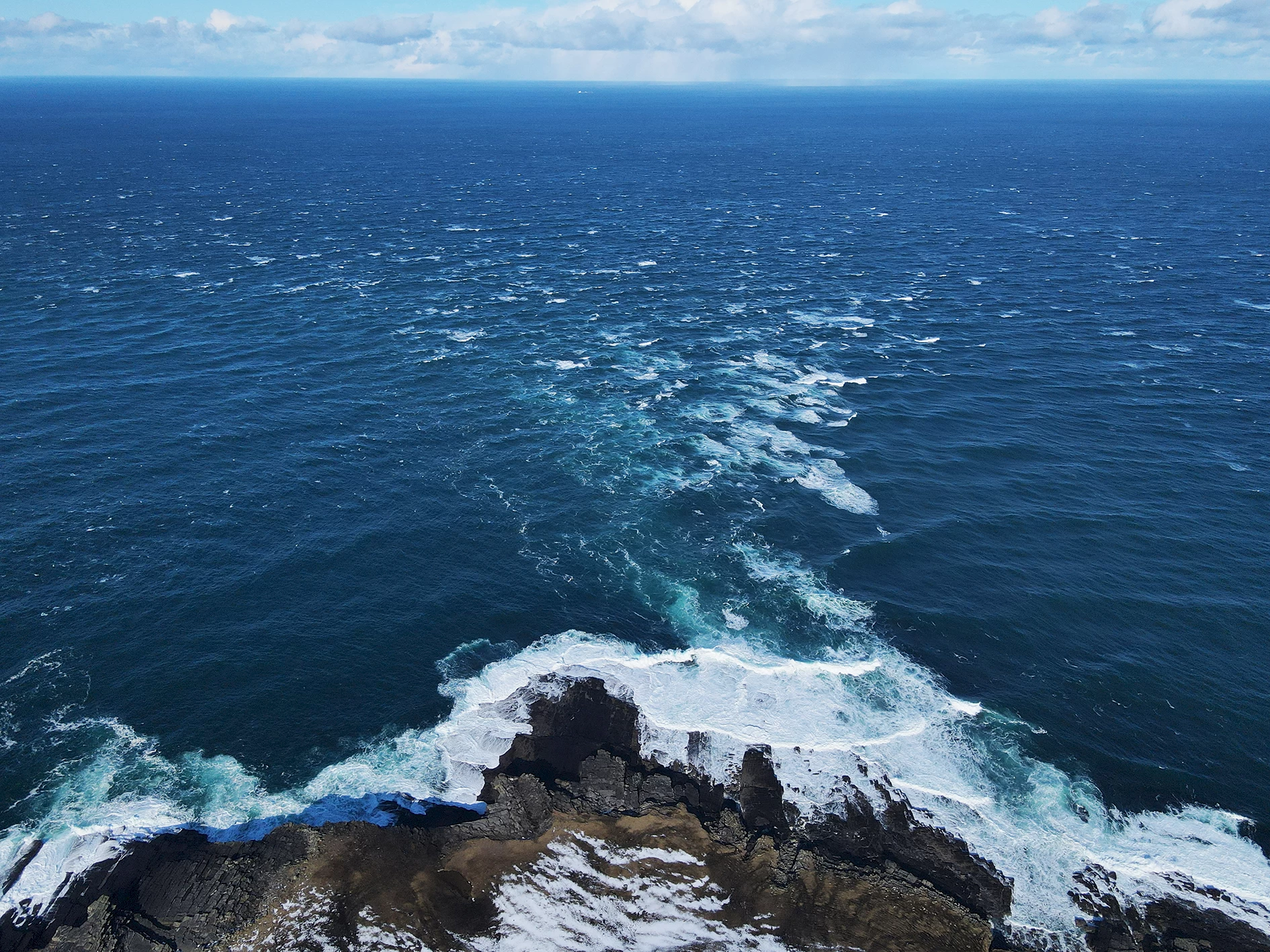
Image courtesy of Jonathan Ford
- 16 - North & South Wick, Papa Westray
The sea at North and South Wick is always a vivid aquamarine, due to its clarity, shallowness and the sand underneath, but the tropical colour belies its chill.
Each island in Orkney has a special stretch of sand, and these neighbouring bays are arguably Papa Westray's entry in Orkney's canon of 'best beaches'. It's from these shores that Amy tries snorkelling for the first time, exploring the world beneath Orkney's waves as if she's 'in a lush forest'. At the north end, Weelie’s Taing is the site of an old harbour which protects a small sea loch and is a good site to spot wading birds.
Image courtesy of Jonathan Ford
- 17 - St Tredwell's Chapel, Papa Westray
It feels at the heart of the island, encircled by a ring of loch, then land, then sea, with fine views across to the Holm and other islands beyond. In Orkney, land is often just a thin division between sky and water: the sea or a loch is nearly always in view.
This small mound, found on a peninsula in St Tredwell's Loch towards the south end of Papa Westray, has long been known as a site of pilgrimage. Structures here date back to the Iron Age with a more recent chapel built on top. Legend has it that St Tredwell, or Triduana, gouged out her eyes and gave them to King Nechtan after he praised their beauty. She was possibly laid to rest here, and miraculous cures for folk suffering from eye problems quickly became associated with the loch. Pilgrims used to travel from across Orkney and further afield looking for cures for their ailments.
Image courtesy of Jonathan Ford
Visiting Papa Westray
Papa Westray is a vibrant community and very much open to visitors.
But because of its size and limited transport and local services, a trip to the island requires careful planning and advance bookings.
Take a look at our information and advice below if you're considering travelling to Papa Westray.
- Travel
Papa Westray has regular ferry and flight connections with the Orkney mainland and neighbouring Westray.
You can reach Papa Westray by boat any day of the week. Orkney Ferries currently operates direct sailings to the island on Tuesdays and Fridays. There are also daily passenger-only crossings between Westray and Papa Westray, with a connecting bus service linking the ferry terminals in Westray. Both boats accept bikes. Book all your ferry tickets online via the Orkney Ferries website.
Papa Westray also has daily flights with Loganair to and from Kirkwall. If you fly via Westray you'll also get to experience the world's shortest scheduled flight, which clocks in at under two minutes. Advance booking for all inter-isles flights in Orkney is essential, especially during the summer months.
- Accommodation
The island's Community Cooperative runs the excellent Papa Westray Hostel at Beltane House, with six en-suite rooms and two camping bothies on offer, as well as general camping space. Booking is essential for both rooms and camping, so do make your reservations as soon as possible to avoid disappointment.
Nistaben is a newly-renovated traditional Orkney croft house within easy walking distance of all Papa Westray's main sites and services. It has two king beds and can sleep up to four people.
- Services
Papa Westray is a small island and easy to get around, with quiet roads and an abundance of shoreline, so the best advice is to explore on foot (and pack accordingly!) Please note there is no bike hire or car hire available locally.
Tours of the island with the local ranger are available between May and September and on demand outwith the summer months. These guided walks offer a perfect introduction to Papa Westray and include many of the locations Amy describes in 'The Outrun'. Booking is essential.
There is a well-stocked shop run by the local Community Cooperative, with fresh produce from the Papay garden on offer, along with general groceries, frozen goods, wines & beer, and a selection of local crafts and postcards.
A weekly 'pub' opens at Beltane House, the island hostel, on Saturday nights, where visitors can meet local folk and enjoy Orkney beers, whiskies, gins, and a selection of soft drinks too. There is also a weekly coffee morning every Wednesday at St Ann’s Kirk, with a selection of home baking.
The Kelp Store Heritage, Art & Craft Centre hosts films, audio recordings, photos and books for anyone interesting in finding out more about Papa Westray's history, or to explore historical family connections.
- Live here
If The Outrun has inspired you to give island life a try, the Papay Development Trust is on the lookout for young families keen to become part of the local community. The Trust's Morven House is available to rent so potential residents can 'try before they buy', offering the perfect opportunity to see if Papa Westray is the place for you. The house is a one and a half storey, stone-built home in the centre of the island with two or three bedrooms and views over open farmland towards St Tredwell's Loch. Find out more by contacting the Trust via papaytrust@gmail.com.
'The Outrun' is available on streaming platforms.
The award-winning book, 'The Outrun', by Amy Liptrot, published by Canongate is available to buy from your local bookshop and online sellers.
